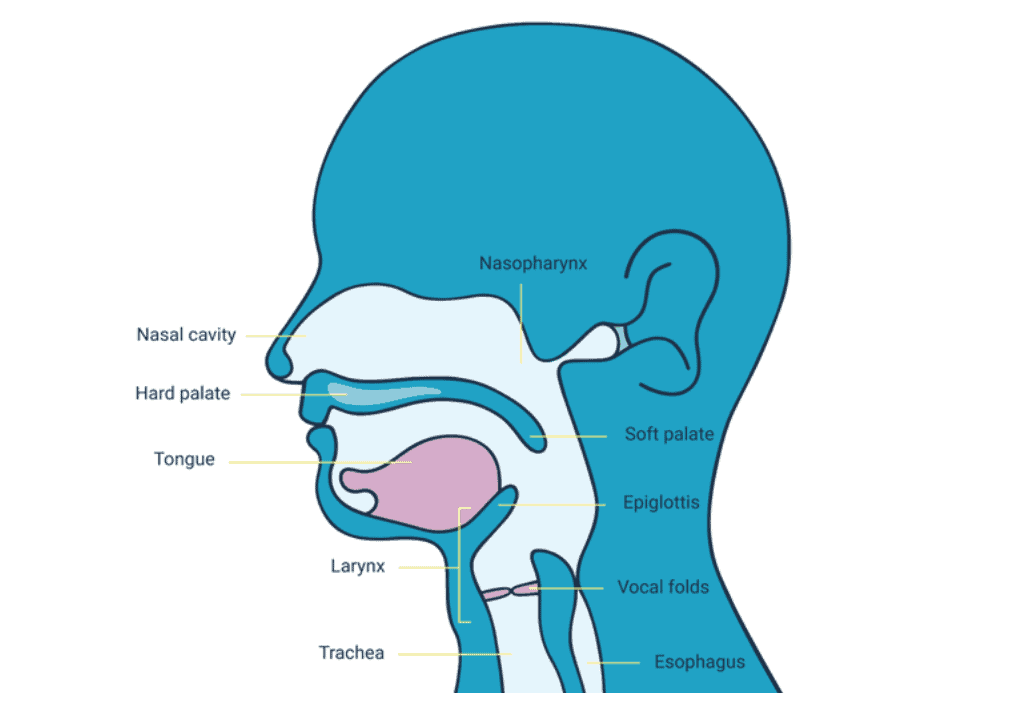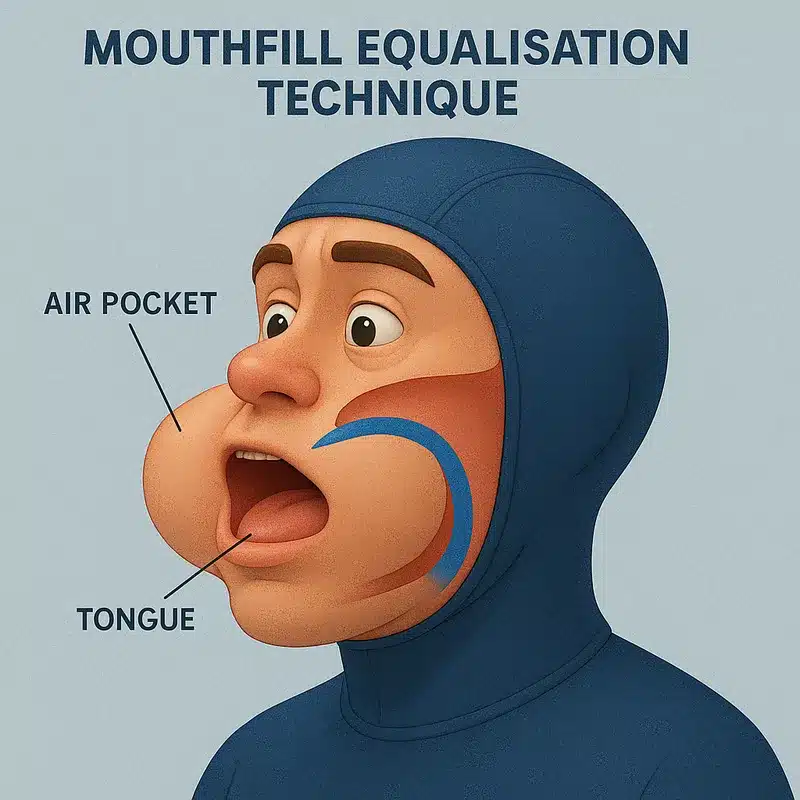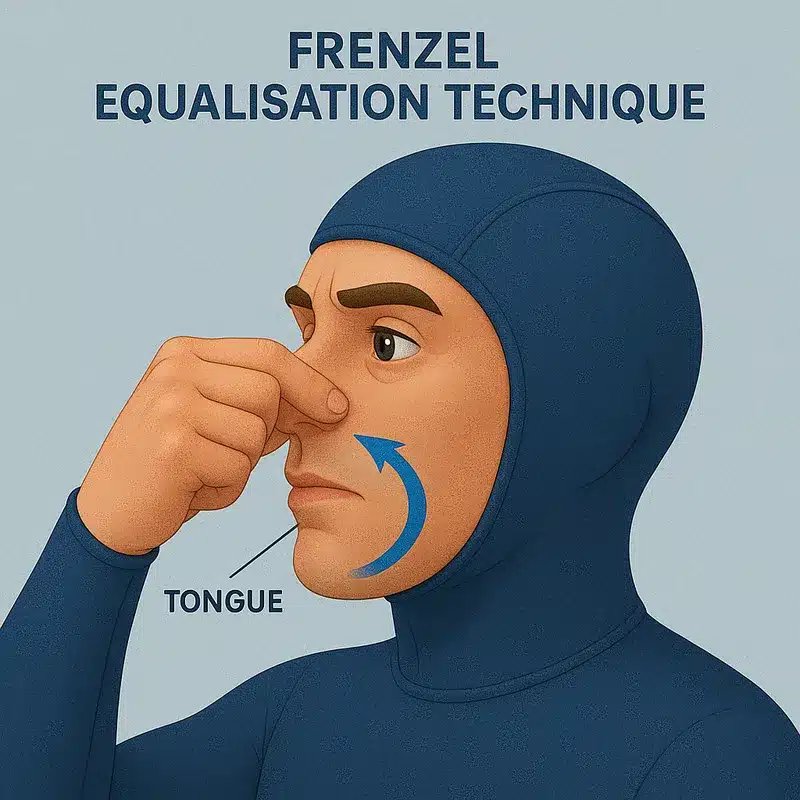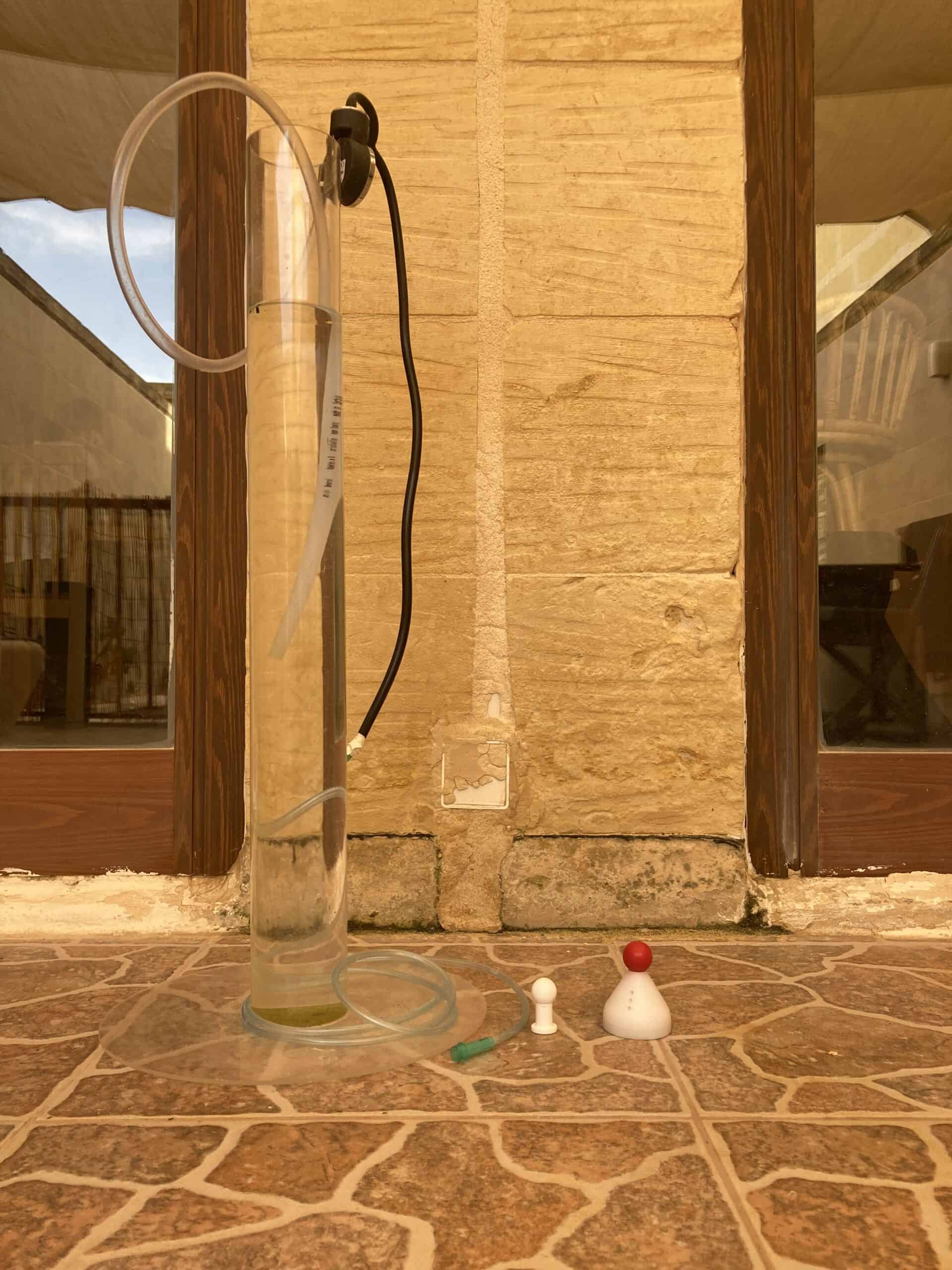Equalisation is a relatively big topic in freediving. From beginners equalisation all the way to advanced, covering movements, air shift techniques, control of certain and specific structures / doors, it comes with good reason. And whilst certain air shift techniques may come ‘naturally’ to some, most freedivers will eventually get stuck at some point. For those who struggle to equalise it’s totally ok, as this is part of your freediving journey. What you need is someone with good knowledge and who can understand your pains to guide you in the right direction with the use of an Ottovent (or EQ tool) and a ballon.
Why do we need to equalise?
Boyles law states that ‘At a fixed temperature, the volume of a gas is inversely proportional to the pressure exerted on that gas’. Most of our body tissues is made of water which is non compressible. However, gases are compressible so freediving has an effect on the airspaces in our body. This is why as we descend, the volume of the air inside our middle ear decreases and we feel an introflection (bending inwards) of the ear drum and this is why we have to equalise. We are compensating for a reduction in volume in the middle ear caused by an increase in pressure.
Three positive things about increasing pressure
- Involuntary equalisation – There is no need to equalise on the way up, Boyle’s law will do it for you. If during your ascent you feel pain, you may be suffering from a reverse block. If so, it means you have some air trapped in the eustachian tubes, and despite the decreasing pressure, they do not open automatically. To try and relieve this problem, suck in air from the mask and swallow. These two actions should hopefully relieve the reverse block.
- The deeper you go, the less you need to equalise – With the increase of depth the equalisation frequency reduces. The first 10 meters are the most critical for equalisation because we need to equalize more often. Knowing your equalisation profile helps you dive safely: how many times do you equalize in the first 10 meters?
- Well being – Pressure generates a positive effect, a feeling of well being that grows with the increasing pressure. Freedivers often say:”I felt so good that I would have stayed much longer”. This sensation is due to hyper oxygenation – i.e., an increasing of PpO2 causing higher Oxygen concentration in blood (Henry’s law). During descent you receive a kind of Oxygen therapy, the benefits of which are normally applied in hyperbaric medicine.
Equalisation anatomy

Eustachian tube
Your eustachian tube is a canal which connects your middle ear cavity to the upper part of your throat and back of your nasal cavity. This is known as the nasopharynx. The pressure within your middle ear is managed by your eustachian tube to ensure it is equal to the pressure outside your body. They are normally closed and only open with certain movements.
Middle ear
Your middle ear is part of the ear between your eardrum and the oval window to your inner ear. During a dive, the volume of air inside your middle ear decreases and puts pressure on your ear drums, casing them to bend inwards. The ear drums are extremely sensitive to changes and this is why it’s important to equalise before you feel any pressure or especially, pain. If you eustachian tubes remain closed or are not opened enough during equalisation, you may experience pain or discomfort. If you continue to descend, you may rupture your ear drums.
Airspaces involved in equalising
An accurate mental mapping will allow you to better understand what happens when you equalize. “Knowing” what should happen will help you “feel” what you are doing, your awareness will become deeper.
There are five airspaces that are involved in equalising which all have air. This air can be shifted from one airspace to another:
- Lungs
- Oral cavity
- Nasal cavity
- Mask
- Middle ear
There are two types of airspaces; Dynamic and Static. A dynamic airspace is one where you are able to change its volume whilst a static airspace is one where it is impossible to change its volume.
Dynamic air spaces:
- Lungs – we can change the volume of lungs by inhalation and exhalation
- Oral cavity – we can change three variables; the jaw, the tongue and the cheeks
Static airspaces:
- Nasal cavity – we can not change the volume of the nasal cavity
- Mask – the mask has no motor skill so this is a static space
- Middle ear – We cannot change the volume of the middle ear. We can only push air inside or open the eustachian tubes.
The Doors that divide airspaces
As mentioned above, there are a few doors that divide these air spaces and these doors are also dynamic and static:
The glottis
The glottis plays another important role and connects the oral cavity to the lungs. It is located near the vocal cord and isolates the digestive track from the airways. It is involved in both frenzel manoeuvre as well as transfer of air from lungs to cavities. The glottis is a Dynamic door.
The mouth
The mouth is connected to the outside by several doors; the lips and the tongue. It is a dynamic door becuase we can open and close our lips with the ‘P-block, T-lock or K-lock’.
Soft Palate
The soft palate connects the oral and nasal cavities & plays one of the most important roles for equalising. It consists of two positions; closed and open (relaxed / neutral position). In order for us to equalise the ear, the palate must be in the open position. This allows the air inside the oral and nasal cavity to be pressurised. Once there is pressure and the soft palate is in the open position, air is forced into the eustachian tubes and has access to the middle ear and ear drum. Because we have total control of the soft pallet, it is considered a dynamic door.
Nostrils
They are the only door that are static. The only way we can close the nostril is by pinching the nose.
Eustachian tubes
The Eustachian tubes are connected to the soft pallet by two muscles. Because we are able to equalise hands free the eustachian tubes are considered a dynamic door.
Deep Equalisation techniques explained.
There are four types of equalisation techniques that freedivers use to descend and everyone has a natural predisposition to each one, namely the valsava of frenzel.
Valsalva Equalisation
This techniques involves the contraction of the abdominals and sometimes also the intercostal muscles. In this case, the glottis is open and pressure is increased in both the lungs and oral cavity. Because of the soft pallet being open, we will have the same pressure increase in the nasal cavity and therefore the ears will equalise. This technique does not allow a freediver to pass depths of 10-20 metres because of the compression of the lungs as we descend. To progress, frenzel equalisation must be used.
Frenzel Equalisation
This technique is undoubtably the preferred method and most efficient. The glottis is closed and air is trapped inside the oral and nasal cavity. By use of the tongue to create pressure by means of the ’T’, ‘Ca’ or ‘H’ lock, pressure is increased in the cavities forcing air into the eustachian tubes. Because of the efficient nature of equalising, a freediver saves energy and oxygen as opposed to compressing the abdominals, diaphragm and chest (valsalva).
On another note, you may also perform a frenzel equalisation by using the jaw or the cheeks to compress the air. Most freedivers and instructors teach frenzel by using the tongue technique. This is because of their lack of knowledge about the subject, whilst only listening and reading what the average manuals have to say. The mouth is a comprehensive pump, use it! Not everyone has the correct motor control to use the tongue in the beginning but they may have good use of the cheeks or jaw.
Check our in-depth guide to frenzel for freediving
Advanced Frenzel Equalisation
This is exactly the same as the frenzel technique, however the freediver at a certain depth will shift air from the lungs into the oral cavity by either reverse packing or by expiratory effort.
Mouthfill Equalisation technique
At a certain depth, air is moved from the lungs into the oral cavity by pronouncing the letter ‘M’. Once the oral cavity is full and your cheeks are inflated, the glottis is then closed. The diver will first create pressure by pressing the cheeks or the jaw in and move on to the ’t’, ‘K’ and ‘G’ lock to use all of the air inside the oral & nasal cavity.
Check our in-depth guide to mouthfill for freediving.
Hands free equalisation
This is self explanatory and is probably the most difficult type of equalisation to achieve (unless you are gifted with a natural ability). The eustachian tubes are mechanically opened through a muscle contraction. The glottis has to be closed and the soft pallets open to allow the passage of air.
Air-shift techniques for equalisation
As a freediver descends the air inside the oral cavity reduces due to boyles law as well as the usage of air being pushed into the middle ear. This means that we need to shift air into the oral cavity from the lungs. The two ways of charging are by expiratory effort (by means of abdominal contraction) which gives a pushing action from the lungs, and by reverse packing which is a pulling action.
When using expiratory effort, the lungs slightly reduce in size and move back shortly after because of their elasticity. When reverse packing, the jaw opens and the tongue moves down, pulling air from the lungs. Reverse packing is a much more relaxing type of air shift technique simply because the body from the throat downwards is disengaged. Having said that, reverse packing is a more complex skill to learn as it involves complete control of the soft pallet, tongue, jaw and glottis.
Check our in-depth article on air-shift techniques.
Building awareness for equalisation.
For those that equalisation does not come naturally, it is highly important to develop awareness of all that is involved, as well as motor control of the doors and airspaces spoken above that we can directly control. The deeper you become familiar and aware of all the parts involved in equalising, the quicker you will perform. Put simply, practice! It is also beneficial to those who equalising comes naturally.
Three simple exercises for building awareness of soft pallet:
- Breathe in the nose and breathe out of the mouth. Practice in front of a mirror so you can see the movement of the soft pallet at the back of your throat. Without the use of the mirror, you can feel the soft pallet open and close.
- Inhale deeply and hold your breath keeping your cheeks inflated. Now blow out though the mouth (slowly) only whilst keeping your cheeks inflated. If no air has moved through your nose, this means your soft pallet is closed.
- Inhale deeply holding your breath and again keeping your cheeks inflated. Slowly, let air out of your nose whilst keeping your mouth shut. You will notice that once you are holding your breath, your soft pallet is closed. As soon as you slowly let air out of your nose, your soft pallet opens. This means air is flowing from your oral to nasal cavity!
Two simple glottis awareness exercises:
- Inhale deeply and hold whilst keeping your mouth open and sticking your tongue out. Make a series of small exhalations whilst being aware of your glottis opening and closing.
- Exhale completely whilst opening your mouth and sticking you tongue out. Infant of a mirror, try to inhale without actually inhaling any air. If you see the skin near your Adam’s apple move inwards and outwards your glottis is closed.
Why can’t I equalise head down / upside down?
It is very common to not manage to equalise when you are in a vertical position and your head pointing downwards. This can be very frustrating however you can overcome this issue. Below are a few reason why you cannot equalise in the head down position.
Headspace & muscle tension
Sometimes our natural human reaction to the change of forward motion can result in subconscious muscle tension that we cannot perceive consciously. Because we are mostly terrestrial mammals, we move forward with our head up (walking). This is how our brain perceives the forward motion. Once we invert ourselves and move in a forward motion (downward) our mind perceives this as a loss of control which can instinctively lead to muscle tension. Self exploration and awareness with a lot of patience and motivation are what is needed to succeed.
Valsalva Manoeuvre
Because it is most likely your first time trying to equalise this way, you do not have enough awareness to notice what type of equalisation you are performing, which could very well be the valsalva manoeuvre. Although it can be possible to equalise this way head down, for some, it is very difficult. Gaining awareness on land is a key factor to begin the process of the equalisation jungle.
Soft pallet control
The most common issue is mechanical where the diver closes the soft pallet by tension or by closing the pallet by pressing the tongue against it. This is very much linked to the first two points above; ‘headspace’ & ‘Valsalva’.
Glottis control
The inverted nature of the freediver causes a pressure difference. The pressure inside the oral cavity is higher than that in the lungs. As we know, air travels from a higher pressure to a lower pressure causing the glottis to open. Strengthening the muscles around the glottis by use of the ottovent is one way to improve control.
Conclusion
Whether an equalisation veteran or not, using an EQ tool is imperative for better motor control of the moving parts as well as awareness. When autonomy is created, you are able to further relax and understand what exactly is going on during your dive. If you would like to improve your skills, get in touch with me. I am a qualified Share Eq instructor and have been thought and guided by Federico Mana, a well known champion in the arts of equalisation.


